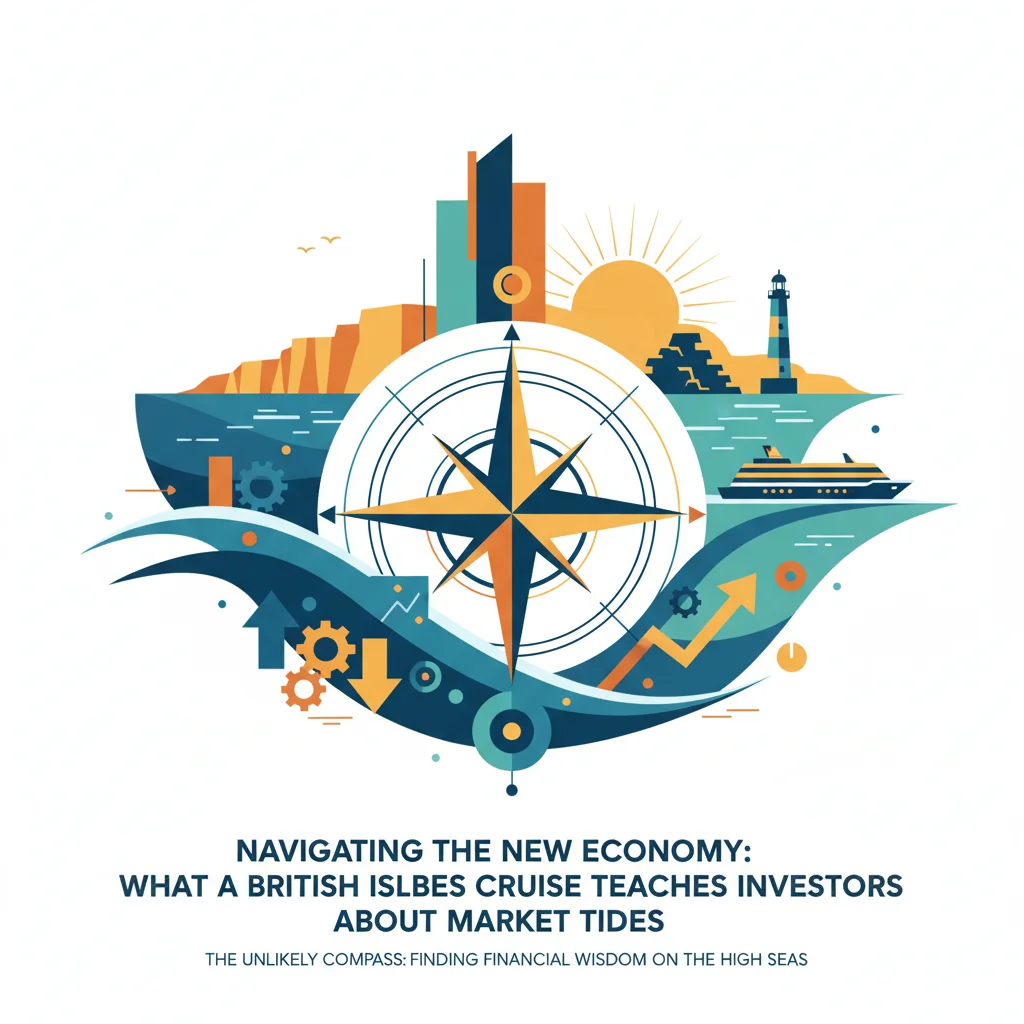
Navigating the New Economy: What a British Isles Cruise Teaches Investors About Market Tides
The Unlikely Compass: Finding Financial Wisdom on the High Seas
At first glance, a travelogue in the Financial Times by food writer Laura Jackson, detailing her family cruise around the British Isles, might seem like an unusual source for market analysis. Titled “cool girls go on cruises,” the piece charts a course through scenic ports, culinary delights, and family adventures. Yet, for the astute investor, business leader, or finance professional, this journey offers a surprisingly potent metaphor for navigating the complex and often turbulent waters of the modern global economy. The principles of a successful voyage—meticulous planning, technological integration, risk management, and seizing unique opportunities—are the very same principles that underpin a robust investment strategy.
In an era defined by rapid technological change and unpredictable market shifts, looking beyond traditional data sets for insightful parallels can unlock new perspectives. The controlled ecosystem of a modern cruise ship, a marvel of logistics, finance, and human experience, serves as a microcosm of our interconnected economic world. By deconstructing Jackson’s voyage, we can extract critical lessons on everything from portfolio diversification and the impact of fintech to the importance of leadership in a crisis. This is more than just a travel story; it’s a blueprint for financial resilience and strategic foresight.
Charting the Course: The Art of Strategic Asset Allocation
Every successful cruise begins long before the ship leaves the dock. It starts with a meticulously planned itinerary, a core principle that directly mirrors the discipline of strategic asset allocation in investing. Jackson’s journey wasn’t a random drift; it was a curated exploration of diverse locations, from the rugged beauty of the Isles of Scilly to the vibrant culture of Dublin. This deliberate selection of varied ports is analogous to building a diversified investment portfolio.
An investor who puts all their capital into a single stock or sector is like a tourist who only visits one city—their experience is limited, and their risk is dangerously concentrated. The cruise itinerary, with its blend of destinations, represents a balanced portfolio of different asset classes: stocks, bonds, real estate, and alternatives. According to the account, the plan to visit five distinct ports in just seven days exemplifies a dynamic diversification strategy. Each port offers a unique “return” in terms of experience, just as each asset class offers a different risk-reward profile. This approach mitigates the risk of a single point of failure—a “bad day” in one market (or a rainy day in one port) doesn’t derail the entire journey.
This principle is fundamental to modern finance. A well-diversified portfolio is designed to weather the storms of the stock market by spreading risk. When one sector of the economy is underperforming, another may be thriving. The goal is not to avoid all risk, but to manage it intelligently, ensuring the overall “voyage” towards one’s financial goals remains on a steady course.
The High-Stakes Calculus: Decoding the Economic Ripple Effects of the Gaza Peace Proposal
The Onboard Ecosystem: A Model for Fintech and Modern Banking
A modern cruise ship is a masterpiece of financial technology. From the moment a passenger steps on board, they enter a seamless, cashless society. Room keys double as credit cards, onboard apps manage everything from dinner reservations to daily spending, and transactions are tracked in real-time. This frictionless experience is a powerful illustration of the revolution that fintech has brought to the traditional world of banking and finance.
The ship’s integrated system—where payments, identity, and services are all connected—is what today’s financial technology companies strive to create for the broader economy. The efficiency of this onboard system, which Jackson alludes to in describing the ease of life at sea (source), minimizes friction and enhances the user experience. This is the same value proposition offered by neobanks, digital payment platforms, and trading apps that simplify complex financial operations for the average user. They are replacing cumbersome, paper-based processes with streamlined, data-driven solutions that put control in the hands of the consumer.
Furthermore, the sheer volume of data generated on a single cruise provides a compelling case study for the power of analytics in business. The cruise line knows passenger preferences, spending habits, and movement patterns. This data allows for hyper-personalized marketing and operational optimization—a strategy that is now central to success in nearly every industry, from retail to investment banking.
Navigating Rough Seas: Volatility, Risk Management, and the Blockchain Parallel
No voyage is without the potential for storms. A sudden squall or unexpected patch of rough water can test the mettle of the ship and its crew. This is the most direct and powerful metaphor for market volatility. The calm, predictable climb of a bull market can give way to a sudden, stomach-churning downturn, and it is in these moments that the quality of leadership and the robustness of systems are truly tested.
Jackson notes the professionalism of the crew during a moment of turbulent weather, a testament to their training and the ship’s advanced stabilization technology (source). In the world of finance, the “captain and crew” are the fund managers, corporate executives, and central bankers. Their ability to remain calm, communicate clearly, and execute a well-rehearsed plan is what separates success from failure during a crisis. The ship’s stabilizers are the hedging instruments and risk management protocols—the derivatives, stop-loss orders, and diversification strategies that protect a portfolio from catastrophic losses.
Extending this further, consider the immense logistical challenge of managing thousands of passengers, crew, and supplies across multiple jurisdictions. The integrity of this entire operation relies on a trusted, transparent ledger of transactions and identities. This is where a concept like blockchain offers a compelling parallel. A decentralized, immutable ledger could revolutionize the cruise industry’s internal banking and supply chain, ensuring every transaction, from a drink purchased at the bar to a container of supplies loaded in port, is securely and transparently recorded. This same technology is poised to reshape the core of our global financial system, offering a new standard for trust and efficiency in trading and settlement.
To better visualize these parallels, consider the direct translation of cruise concepts into the language of finance and investing:
| The Cruise Analogy | The Financial Principle |
|---|---|
| The Planned Itinerary | Strategic Asset Allocation & Portfolio Diversification |
| The Ship’s Captain & Crew | Fund Management & Corporate Leadership |
| Onboard Cashless System | Fintech, Digital Wallets, and Modern Banking |
| Advanced Ship Stabilizers | Risk Management & Hedging Instruments |
| Shore Excursions | Niche Market Investing & Seeking Alpha |
| Ship’s Operational Ledger | Blockchain Technology & Transparent Trading |
Shore Excursions: The Hunt for Alpha in Niche Markets
A key part of the cruise experience is the shore excursion—the opportunity to disembark and explore a port in greater detail. These excursions are not one-size-fits-all. Some passengers choose the mainstream city tour, a safe and predictable option. Others, however, might opt for a specialized food tour, a challenging hike, or a visit to a local artisan’s workshop. This choice is a perfect metaphor for the search for alpha in investing.
The “mainstream tour” is akin to investing in a broad market index fund. It’s a reliable strategy that will deliver the market’s average return. However, for those seeking to outperform the market (generate “alpha”), a deeper dive is required. The specialized excursions represent investments in niche markets, emerging industries, or undervalued assets that require more research and carry a different risk profile but offer the potential for outsized returns. Jackson, a food writer, naturally gravitated towards unique culinary experiences, a choice that highlights the value of leveraging specialized knowledge to uncover unique opportunities (source). Similarly, an investor with deep knowledge of the biotechnology sector or renewable energy might be better positioned to identify high-growth companies that the general market has overlooked.
This approach is central to active investment management. It requires moving beyond the obvious, conducting deep due diligence, and having the conviction to invest in areas that are not yet on every investor’s radar. Just as the most memorable travel experiences often happen off the beaten path, the greatest investment opportunities are frequently found away from the crowded trades.
Cracking the Code: What a Simple Numbers Puzzle Reveals About Modern Finance
Conclusion: Setting Sail with Confidence
Laura Jackson’s family cruise, while a delightful travel narrative on its surface, offers a surprisingly deep well of wisdom for those navigating the modern economy. The journey serves as a powerful reminder that the core principles of success are universal. A well-planned itinerary is a diversified portfolio. A state-of-the-art ship is a technologically advanced financial platform. A skilled crew is a disciplined management team. And a willingness to explore beyond the obvious is the key to discovering unique value.
As we face an economic future marked by both incredible opportunity and significant uncertainty, the lessons from this voyage are more relevant than ever. Success will not be determined by blindly following the herd, but by charting a deliberate course, embracing the tools of financial technology, managing risk with discipline, and having the courage to explore new horizons. For investors and business leaders alike, the message is clear: build a vessel strong enough for any storm, and you can set sail toward your financial destination with confidence.

